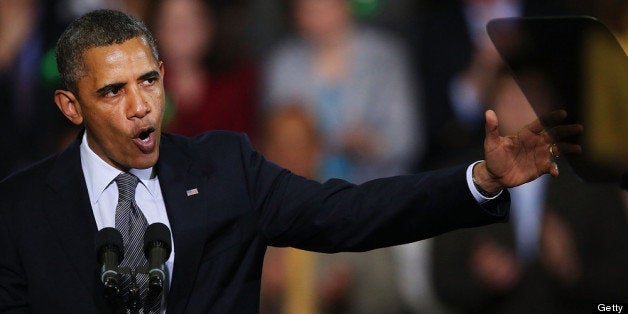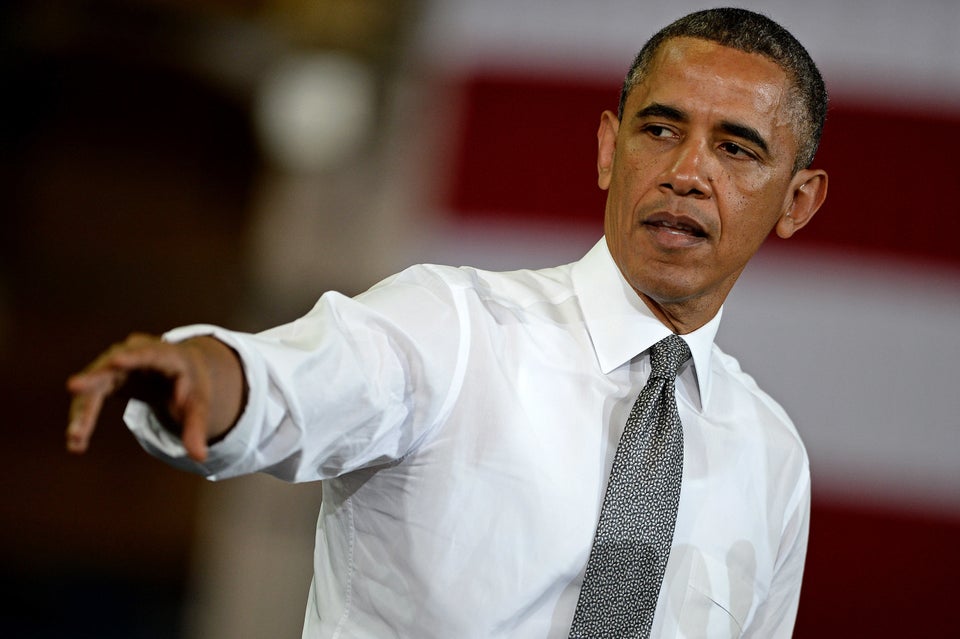
When Chris Cillizza writes, as he did Monday, that the "bully pulpit just ain’t what it used to be," it primes me to expect that some exciting news is coming. Specifically, that somehow, the "bully pulpit" has been transformed into some incredibly effective tool for moving opinion. I mean, I can't point to any recent examples of that happening, but I've been binge-watching "Arrested Development" lately, so it's possible I may have missed some huge, dramatic turnaround in the power of the bully pulpit.
As it turns out, however, the status quo ante seems to be in place. Cillizza goes on at length to say that the "bully pulpit is less bully these days." He takes a good stab at explaining why this is. In his brief, Cillizza says that there are a lot of news organizations now -- "a million smaller shards [of media] makes that sort of agenda-driving incredibly difficult." He also says that the news moves at a frenetic pace that precludes "pro-activeness," and forces "reactiveness." Also, "America is so polarized," et cetera. But the plain and simple truth is that the bully pulpit is already zero bully, and it has been for a long time, so it is really hard to see how it can get less bully than "no bully."
If you want definitive proof that the bully pulpit is a pretty ineffective tool for convincing or persuading people, one need only look at the fact that political scientists keep on seizing their bully pulpit to point out how little impact the bully pulpit has, and they've failed to convince people! For once, we have a tautology that you can believe in.
Remember FDR's "fireside chats?" If you do, you are probably remembering them way too fondly. Here's Ezra Klein, citing George Edwards and his book On Deaf Ears: The Limits Of The Bully Pulpit:
Franklin Delano Roosevelt’s fireside chats are perhaps the most frequently cited example of Presidential persuasion. Cue Edwards: “He gave only two or three fireside chats a year, and rarely did he focus them on legislation under consideration in Congress. It appears that FDR only used a fireside chat to discuss such matters on four occasions, the clearest example being the broadcast on March 9, 1937, on the ill-fated ‘Court-packing’ bill.” Edwards also quotes the political scientists Matthew Baum and Samuel Kernell, who, in a more systematic examination of Roosevelt’s radio addresses, found that they fostered “less than a 1 percentage point increase” in his approval rating. His more traditional speeches didn’t do any better. He was unable to persuade Americans to enter the Second World War, for example, until Pearl Harbor.
And here is John Sides, bringing Edwards' work to a more recent presidency:
Presidential speeches don’t tend to persuade people on policy either. Take the “Great Communicator,” Ronald Reagan. In "The Strategic President," George Edwards shows that Reagan could not move opinion on signature issues like aid to the contras. And Reagan’s advocacy for increased defense spending was soon followed by a decrease in support for additional defense spending. Public opinion on government spending often moves in the opposite direction as presidential preferences and government policy.
Chances are, it won’t. Even Reagan realized this. In his own words:
"Time and again, I would speak on television, to a joint session of Congress, or to other audiences about the problems in Central America, and I would hope that the outcome would be an outpouring of support from Americans … But the polls usually found that large numbers of Americans cared little or not at all about what happened in Central America … and, among those who did care, too few cared … to apply the kind of pressure I needed on Congress."
And you can also think about George W. Bush and the effort to reform Social Security.
As Atrios points out, polling suggests President Bush's speech failed to overcome the public's opposition to an increase in troop levels in Iraq:
"President Bush's address to the nation last week failed to move public opinion in support of his plan to increase U.S. troop levels in Iraq and left Americans more pessimistic about the likely outcome of the war.
In a USA TODAY/Gallup Poll taken Friday through Sunday, more than 6 of 10 people back the idea of a non-binding congressional resolution expressing opposition to Bush's plan to commit an additional 21,500 U.S. troops to Iraq."
But we shouldn't be surprised by this. As I pointed out back in February 2005, in the context of President Bush's push for private accounts in Social Security, the evidence indicates that presidents and political elites can rarely move public opinion significantly in their direction through PR campaigns. But the myth of the bully pulpit persists because journalists are generally ignorant about political science or quantitative evidence more generally.
More broadly, let's engage in a thought exercise. Let's say that the current occupant of the White House is a silver-tongued devil of a speaker -- just the most gorgeous orator in the history of the realm. And let's say that I am not blogger Jason Linkins, let's say that I am Sen. Jason Linkins (I-WTFistan). Give all the speeches you want, Mr. President Silver Tongued-Devil. Go out there and emote. Rend your garments. If I can rustle up a super-minority of senators to quietly filibuster what you want to do, I beat you and your bully pulpit every time.
That's largely what's happening now. (Though occasionally you can defeat Obama's bully pulpit remonstrations about closing Gitmo by simply assembling a coalition of Democrats unwilling to risk being called "soft on the war on terror" to simply block the provision of funding for your Gitmo-closing ambitions.)
The word "filibuster" never appears in Cillizza's column, and it really should, because that right there's the whole shooting match.
Now, I suppose that if enough influential people in the political media gradually presented the case that filibustering everything under the sun is not normative, perhaps over time, a political cost could be attached to filibustering everything under the sun. But for the most part, the influential voices in the political media are neutral on the filibuster. They correctly point out that if you examine the history of using the filibuster tactic, you can find examples of "both sides doing it too." But the sort of people who will tell you that it's getting abused don't get booked on Sunday shows to talk about it. And so, no political cost is ever paid for obstruction. (And by the way, there's no reason to believe that won't continue as the way of doing business in the Senate, unless a self-sacrificing band of Democrats decide to deny themselves the tool.)
The good news here is that persuasion from a sort of "pulpit" is possible. As Sides has pointed out many a time, "What presidents can do, Edwards argues, is 'facilitate' change in favorable environments." The takeaway then, is that "bully pulpit persuasion" doesn't have a short game. It's a long and circuitous and time-consuming process, in which a president does not so much "persuade lots of recalcitrant voters or members of Congress," as merely "signal the president’s intention to push for these policies and, equally if not more important, to bargain about these policies."
Per Sides:
In other words, the speech, whatever its tone, was not laying proposals that are set in stone. Expect the speech simply to spawn additional debate and negotiation.
If the end result is a bill on the president’s desk, we’ll have an excellent example of how presidential leadership really works. It’s not about magic words or eloquent moments. As Edwards said, it’s about facilitating change.
Let me give you a cheap, side-of-the-cereal-box example of how "facilitating change in a favorable environment" works. One day, Vice President Joe Biden is on Meet The Press, and he says, "I am absolutely comfortable with the fact that men marrying men, women marrying women and heterosexual men marrying women are entitled to the same exact rights." The next thing you know, Obama is forced to respond to this (my God, he has to be "reactive" and not "pro-active!") and he, too, comes out in favor of marriage equality. And the next thing you know, Jay-Z is on board and a bunch of states are successfully making marriage equality legal and Mark Kirk is offering gorgeously poetic support for the same and now even Lisa Murkowski is on board.
Power of the bully pulpit? Nay, friends. Marriage equality was already very broadly popular at the time Biden went on Meet The Press. Biden just took that favorable environment and facilitated himself a little change! Had Biden come out in favor of something that wasn't popular, like, "Let's bomb Ontario" or, "Can we maybe stop putting ramps in every recipe," it wouldn't have moved the needle.
Now, unfortunately, here is where what Cillizza mentions -- about the splintered media, and the relative speed of the news -- really does come into play. If the media game is all about "jump on the shiny shiny," there is not going to be a whole lot of drive or effort put behind covering or explaining the long process of "facilitating change in favorable environments" or the bargaining or the trade-offs. Usually, you get that story after something has already been accomplished.
So you will get really good after-the-fact stories, like this one from Carrie Budoff Brown and Manu Raju, titled "Inside the border deal that almost failed." If more people took these stories seriously, and understood all the complicated wheeler-dealing that actually resolves these kinds of matters, people would feel okay about letting go of the myth of the bully pulpit.
(By the way: What would happen if President Barack Obama took to the bully pulpit to loudly praise Marco Rubio effusively for his work on comprehensive immigration reform? The reform bill would fail. So much for the bully pulpit! Sometimes you facilitate change in a favorable environment by not seeming to do anything at all.)
So, in the end, where and on what occasion does the presidential "bully pulpit" work? Basically, in the movies, when you only have two hours of plot to resolve matters that normally take months, and you need a cool plot device for the final reel.
That's where the bully pulpit works, and nowhere else, and it has always been this way, and it always shall be, the end.
[Would you like to follow me on Twitter? Because why not?]
This story appears in the special July 4 issue of our weekly iPad magazine, Huffington, in the iTunes App store, available Friday, June 28.

